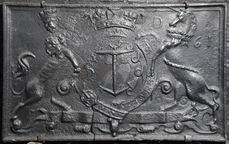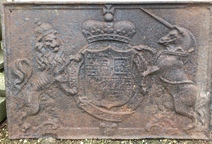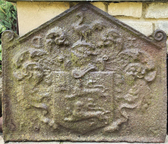-
220
Description: Rectangular with cavetto moulded edging; English Royal supporters (crowned lion and unicorn) standing upon a cartouche, upon which rests a blank motto scroll; above, an anchor, surrounded by a looped cable is encircled by the Garter ribbon, which is surmounted by a royal coronet; the numbers ‘61’, presumably part of the date, are to the right of the unicorn, and a letter, ‘D’, is placed between the unicorn and the coronet.
Notes: From another casting of the same back, the date is known to be 1661. The cabled anchor is the badge of the Lord High Admiral who, in 1661, was the Duke of York and Albany, later James II. The missing initial is an ‘I’, for Jacobus Dux. The absence of the motto may be explained by the pattern being a carved armorial panel where the motto text, unlike that of the Garter, was merely painted.
Copies of this fireback are known.
Inscription: [I] D / 16 61
Arms: Lord High Admiral of England
- Decoration tags:
- rectangular (shape)
- cavetto (edging)
- whole carved pattern
- individual letters
- individual numbers
- armorial
- text
Manufactured: in 1661 possibly in the Weald area of England.
Current location: Preston Manor, Brighton, East Sussex, England.
Museum number: PM400269 (part of the Brighton Museum museum group)
- Attached to series:
- Miscellaneous royal firebacks
-
487
Description: Rectangular; cavetto-moulded edging; shield, garter, supporters and crown of the English royal house of Stuart.
Notes: One of many designs of the Stuart royal arms on firebacks. Another, corroded version of this fireback measures 900mm x 610mm. Criterion Auctions, Bath, 10 Sep 2016 lot 168.
Copies of this fireback are known.
Inscription: HONY SOIT QUI MAL Y PENSE
Arms: English Stuart royal
- Decoration tags:
- rectangular (shape)
- cavetto (edging)
- whole carved pattern
- armorial
- royal
Manufactured: in the mid- to late-17th century in England.
Current location: not known.
- Attached to series:
- Stuart royal armorial firebacks
-
276
Description: Arched rectangular shape; cavetto moulding all round; spreading oak tree, with leaves and acorns, filling the whole plate; three royal crowns, one at the top of the tree, the other two symmetrically on the ends of branches towards the top corners; initials GR towards the bottom corners, the remaining inscription on a scroll across the base.
Notes: The design is derived from the celebrated occasion when Charles II evaded his pursuers by hiding in an oak tree at Boscobel House, near Wolverhampton, following the final Royalist defeat at the battle of Worcester in 1651. This popular fireback has been copied frequently, and in this recast example the inscription has been re-modelled, with the traditional CR (for Carolus Rex) replaced by GR (for Georgius Rex - George V). Copies of this fireback were advertised in Bratt Colbran Ltd.'s (London) catalogue in the early-20th century.
Inscription: G THE ROYALL OAK R
- Decoration tags:
- rectangular with round arch (shape)
- cavetto (edging)
- whole carved pattern
- pictorial
- royal
- text
- plants
Manufactured: in the early-20th century in England.
Current location: Chequers, Ellesborough, Buckinghamshire, England.
- Attached to series:
- Commemorative firebacks
-
1302
Description: Triangular arched shape; double fillet edging with scrolls above the top corners; in front of mantling, a shield bearing two lions passant guardant with an indistinct canton; above it a helm and crest of a probable ostrich; initials, the D reversed, to left and right of upper mantling.
Notes: The arms have not been identified
Inscription: D T
Arms: Not known
- Decoration tags:
- triangular arched (shape)
- double fillet (edging)
- whole carved pattern
- individual letters
- heraldic
- armorial
- text
Manufactured: in the 17th century in England.
Current location: Francis Barber Architectural Salvage, Kelmscott, Gloucestershire, England.
- Attached to series:
- Personal armorial firebacks
- Loop edged firebacks
-
1252
Description: Quasi-arched rectangular shape; no edging; arched rectangular central panel edged with a garland within a cartouche between guilloche-moulded bands that extend vertically below to form two further panels separated by a similar but plain band; the two bottom panels each extend sideways to form simulated pedestals; below is a plain, borderless panel. Within the main panel, at each corner a cherub head facing towards the centre; within the border of the panel, a symmetrical strapwork band forms the edge of a cartouche that is scrolled at the bottom and which curves away from the edge of the panel at the sides to reveal scrolls from behind, and which forms a heart shape in front of each of the putti enclosing an indeterminate feature; in the centre of the panel, resting upon a scrolled cartouche with scallop shells to left and right, a gadrooned medallion enclosing the depiction of an empty mural monument, draped from above and with a lion's mask below. Resting upon the pedestal to the right, a consol enclosing an indeterminate circular feature with two descending bands; on the pedestal to the left a similar consol and indeterminate circular feature but with a single descending band; above each consol the head of a classical deity facing to right and left respectively, above which are rows of vertical figures, four on the left and two on the right, which may be caryatid figures possibly intended to depict the Daughters of Athens on the Parthenon; above the main panel symmetrical scrolls. In the lower panel, a central rectangular cartouche, scrolled at the top and bottom, between symmetrical vignettes.
Notes: Some of the detail is too indistinct to permit accurate description, but a fireback of untypical design features that are all characteristic of the early-17th century, and derivative of the designs of the likes of Jan Vredemen de Vries and Frans Huys.
Copies of this fireback are known.
- Decoration tags:
- rectangular with ornate arch (shape)
- none (edging)
- whole carved pattern
- architectural
- humans
- objects
Manufactured: in the early- to mid-17th century in England.
Current location: in private hands, Wartling, East Sussex, England.
- Attached to series:
- Miscellaneous pattern firebacks




